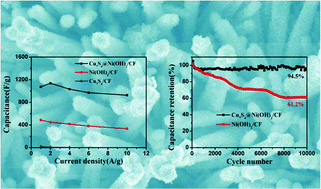Metal–organic framework templated fabrication of Cu7S4@Ni(OH)2 core–shell nanoarrays for high-performance supercapacitors†
Abstract
Well-controlled core–shell nanostructured arrays are highly attractive and rational combination of hybrid electrochemical active materials as promising candidate electrodes for supercapacitors still remains a great challenge. In this work, ultrathin Ni(OH)2 nanosheets as the “shell” were anchored on Cu7S4 nanorods as the “core” to form core–shell hybrid nanoarrays on copper foam (CF), which were firstly fabricated by a facile metal–organic framework templated synthetic strategy with a three-step procedure of in situ interface growth, sulfurization and hydrothermal synthesis. The core–shell Cu7S4@Ni(OH)2/CF hybrid nanoarrays as binder-free electrodes show a high specific capacitance of 1072.5 F g−1 (482.6 C g−1) at a current density of 1 A g−1, superior rate capacity of 86.4% at 10 A g−1 and an outstanding cycling stability of 94.5% capacitance retention after 10 000 cycles. What's more, the assembled asymmetric supercapacitor device based on Cu7S4@Ni(OH)2/CF as a positive electrode and activated carbon (AC) as a negative electrode shows a high energy density of 52.5 W h kg−1 at a power density of 750 W kg−1 with decent cycling stability. This strategy can be extended to form other unique copper sulfide-based core–shell nanoarray architectures with enhanced electrochemical activity for high-performance energy storage devices.



 Please wait while we load your content...
Please wait while we load your content...